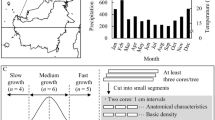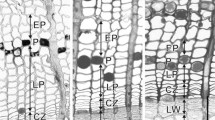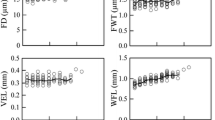Abstract
Xylem cell length of juvenile tree rings was investigated in poplars in order to check the hypotheses that fiber length or vessel element length are indicative of drought tolerance and have predictive value for final stem base diameter at the end of rotation. The radial increment in the drought year 2003 served as the reference indicator for quantifying drought tolerance. All nine investigated cultivars suffered severely. In terms of their moderately decreased radial increment in 2003, the two aspen cultivars were clearly less drought susceptible than the seven hybrid poplar cultivars. The variance components of xylem cell length data explained by the two genetic factors ‘cultivar’ and ‘botanic section’ as well as the ‘tree ring’ (of the years 2002 and 2003) were compared by means of ANOVAs. The cultivar effects were superior to the effects of the critical precipitation status in 2003 and the botanic section. Fiber and vessel element length were found to be less sensitive to the drought compared with radial increment. They did neither correlate with radial increment in the drought year 2003 nor in 2002. Therefore, higher xylem cell length cannot indicate drought tolerance in poplars. However, a linear relationship between fiber length of both juvenile tree rings and the stem base diameter proved to be highly significant to a linear mixed effect model. Higher fiber length of a juvenile tree ring was considered to be predictive of larger stem base diameter at the end of rotation.


Similar content being viewed by others
Abbreviations
- FL:
-
Libriform fiber cell length (or fiber length)
- i r :
-
Radial increment
- SRF:
-
Short rotation forestry
- VEL:
-
Vessel element length (or vessel cell length)
References
Arend M, Fromm J (2003) Ultrastructural changes in cambial cell derivatives during xylem differentiation in poplar. Plant Biol 5(3):255–264
Arend M, Fromm J (2007) Seasonal change in the drought response of wood cell development in poplar. Tree Physiol 27(7):985–992
Blake TJ, Sperry JS, Tschaplinski TJ, Wang SS (1996) Water relations. In: Stettler R, Bradshaw HD, Heilman PE, Hinckley TM (eds) Biology of Populus and its implications for management and conservation. NRC Research Press, Ottawa, pp 515–539
BLE (2012) Die Pappel—Klone, Klonmischungen und Familieneltern (BLE). Federal Office for Agriculture and Food, Referat 324, Deichmanns Aue 29, 53179 Bonn, Germany
Cocozza C, Giovannelli A, Traversi M, Castro G, Cherubini P, Tognetti R (2011) Do tree-ring traits reflect different water deficit responses in young poplar clones (Populus × canadensis Mönch ‘I-214’ and P deltoides ‘Dvina’)? Trees—Struct Funct 25(6):975–985
Cohen J (1973) Eta-squared and partial eta-squared in fixed factor ANOVA designs. Educ Psychol Meas 33(1):107–112
DeBell JD, Gartner BL, DeBell DS (1998) Fiber length in young hybrid Populus stems grown at extremely different rates. Can J Forest Res 28(4):603–608
Deslauriers A, Giovannelli A, Rossi S, Castro G, Fragnelli G, Traversi L (2009) Intra-annual cambial activity and carbon availability in stem of poplar. Tree Physiol 29(10):1223–1235
Fang SZ, Xu XZ, Lu SX, Tang LZ (1999) Growth dynamics and biomass production in short-rotation poplar plantations: 6-year results for three clones at four spacings. Biomass Bioenerg 17(5):415–425
FNR (2011) Anbaufläche für nachwachsende Rohstoffe. German Agency for Renewable Resources. http://www.fnr.de. Accessed 14 July 2012
Goyal GC, Fisher JJ, Krohn MJ, Packood RE, Olson JR (1999) Variability in pulping and fiber characteristics of hybrid poplar trees due to their genetic makeup, environmental factors, and tree age. Tappi J 82(5):141–147
Gruss K, Becker G (1993) Anatomische und technologische Eigenschaften des Holzes ausgewählter Pappelklone und ihr Einfluss auf ihre industrielle Verwertung. In: Hüttermann A (ed) Anbau von Pappel bei mittlerer Umtriebszeit. J.D. Sauerländer’s Verlag, Frankfurt am Main, pp 92–112
Hsiao TC (1973) Plant responses to water stress. Annu Rev Plant Physiol Plant Mol Biol 24:519–570
Hurlbert SH (1984) Pseudoreplication and the design of ecological field experiments. Ecol Monogr 54(2):187–211
Ivkovich M (1996) Genetic variation of wood properties in balsam poplar (Populus balsamifera L.). Silvae Genet 45(2–3):119–124
Jeffrey EC (1917) The anatomy of woody plants. University of Chicago Press, Chicago
Klasnja B, Kopitovic S, Orlovic S (2003) Variability of some wood properties of eastern cottonwood (Populus deltoides Bartr.) clones. Wood Sci Technol 37(3–4):331–337
Koubaa A, Hernandez RE, Beaudoin M, Poliquin J (1998) Interclonal, intraclonal, and within-tree variation in fiber length of poplar hybrid clones. Wood Fiber Sci 30(1):40–47
Krabel D (2000) Influence of sucrose on cambial activity. In: Savidge RA, Barnett JR, Napier R (eds) Cell and molecular biology of wood formation. BIOS Scientific Publishers, Oxford, pp 112–126
Krabel D, Bodson M, Eschrich W (1994) Seasonal-changes in the cambium of trees. 1. Sucrose content in Thuja occidentalis. Bot Acta 107(1):54–59
Krabel D, Roloff A, Bodson M (1999) Influence of sucrose on seasonal cambial growth. J Exp Bot 50((suppl)):25–26
Küchler W (2004) Die Dürreperiode 2003 in Sachsen (The drought period of 2003 in Saxony. German). http://www.smul.sachsen.de/umwelt/download/klima/duerrebericht_2003_2.pdf. Landesamt für Umwelt und Geologie, Dresden. Accessed 8 Mar 2012
Liese W, Ammer U (1958) Untersuchungen über die Länge der Holzfaser bei der Pappel. Holzforschung 11(5/6; special issue on Populus research):165–174
Liesebach M, von Wühlisch G, Muhs H-J (2000) Überlegenheit von Aspen-Arthybriden bei der Biomasseproduktion im Kurzumtrieb. Die Holzzucht 12:11–18
Liesebach H, Schneck V, Ewald E (2010) Clonal fingerprinting in the genus Populus L. by nuclear microsatellite loci regarding differences between sections, species and hybrids. Tree Genet Genomes 6(2):259–269
Luo ZB, Langenfeld-Heyser R, Calfapietra C, Polle A (2005) Influence of free air CO2 enrichment (EUROFACE) and nitrogen fertilisation on the anatomy of juvenile wood of three poplar species after coppicing. Trees—Struct Funct 19(2):109–118
Mátyás C, Peszlen I (1997) Effect of age on selected wood quality traits of poplar clones. Silvae Genet 46(2–3):64–72
Mellerowicz E, Baucher M, Sundberg B, Boerjan W (2001) Unravelling cell wall formation in the woody dicot stem. Plant Mol Biol 47(1–2):239–274
Meyer M (2010) Trockenheitsreaktionen und holzanatomische Eigenschaften der Zitter-Pappel (Populus tremula L.)—Physiologie und QTL-mapping/water deficit reaction and wood anatomical characteristics of European aspen (Populus tremula L.)—Physiology and QTL-mapping (doctoral dissertation in German with English abstract and captions), vol 31. Forstwissenschaftliche Beiträge Tharandt/Contributions to Forest Science. Eugen Ulmer GmbH & Co., Stuttgart
Meyer-Uhlenried KH (1959) Über die Vererbung von Holzfaserlängen bei verschiedenen Arten der Gattung Populus. Der Züchter (Theor Appl Genet) 29(3):117–123
Monclus R, Dreyer E, Villar M, Delmotte FM, Delay D, Petit JM, Barbaroux C, Thiec D, Brechet C, Brignolas F (2006) Impact of drought on productivity and water use efficiency in 29 genotypes of Populus deltoides x Populus nigra. New Phytol 169(4):765–777
Monteoliva S, Senisterra G (2008) Site, hybrid crosses and clone effect on growth and wood properties of Populus. Invest Agrar-Sist R 17(3):261–270
Nepveu G, Keller R, Teissierducros E (1978) Juvenile selection for wood quality in Populus nigra and Populus euramericana. Ann Sci For 35(1):69–92
Pande PK, Dhiman RC (2011) Performance and variability patterns in wood properties and growth traits in the parents, F1 and F2 generation hybrid clones of Populus deltoides. J For Res (Harbin) 22(3):379–385
Peszlen I (1994) Influence of age on selected anatomical properties of Populus clones. Iawa J 15(3):311–321
Petzold R, Schwärzel K, Feger KH (2011) Transpiration of a hybrid poplar plantation in Saxony (Germany) in response to climate and soil conditions. Eur J For Res 130(5):695–706
Schreiber SG, Hacke UG, Hamann A, Thomas BR (2011) Genetic variation of hydraulic and wood anatomical traits in hybrid poplar and trembling aspen. New Phytol 190(1):150–160
Schreiner EJ (1927) The breeding of forest trees for pulp wood. J N Y Bot Gard 28(327):49–63
Spinelli R, Magagnotti N, Nati C (2011) Work quality and veneer value recovery of mechanised and manual log-making in Italian poplar plantations. Eur J For Res 130(5):737–744
Stanton B, Eaton J, Johnson J, Rice D, Schuette B, Moser B (2002) Hybrid poplar in the Pacific northwest—the effects of market-driven management. J For 100(4):28–33
Stettler R, Zsuffa L, Wu R (1996) The role of hybridization in the genetic manipulation of Populus. In: Stettler R, Bradshaw HD, Heilman PE, Hinckley TM (eds) Biology of Populus and its implications for management and conservation. NRC Research Press, Ottawa, pp 87–112
Stout AB, Schreiner EJ (1933) Results of a project in hybridizing poplars. J Hered 24(6):217–229
Telewski FW, Aloni R, Sauter JJ (1996) Physiology of secondary tissues of Populus. In: Stettler R, Bradshaw HD, Heilman PE, Hinckley TM (eds) Biology of Populus and its implications for management and conservation. NRC Research Press, Ottawa, pp 301–329
Trendelenburg R, Mayer-Wegelin H (1955) Das Holz als Rohstoff. Hanser, München
West BT, Welch KB, Gałecki AT (2007) Linear mixed models: a practical guide using statistical software. Chapman & Hall/CRC, Taylor and Francis Group, Boca Raton
Wolf H, Bönisch B (2004) Anbau schnellwachsender Gehölze auf stillgelegten landwirtschaftlichen Flächen zur Holzstoffproduktion—Plantation of fast growing woody species on set aside agricultural land for the production of pulp wood (German with English abstract). In: Begemann F, Schröder S (eds) Produktvielfalt durch Ressourcenvielfalt—Potenziale genetischer Ressourcen (conference proceedings), Bonn, Germany, 2003. Zentralstelle für Agrardokumentation und -information (ZADI), Federal Office for Agriculture and Food, Bonn, pp 122–132
Yanchuk AD, Micko MM (1990) Radial variation of wood density and fiber length in trembling aspen. Iawa Bull 11(2):211–215
Yanchuk AD, Dancik BP, Micko MM (1984) Variation and heritability of wood density and fiber length of trembling aspen in Alberta, Canada. Silvae Genet 33(1):11–16
Yu QB, Tigerstedt PMA, Haapanen M (2001) Growth and phenology of hybrid aspen clones (Populus tremula L. x Populus tremuloides Michx.). Silva Fenn 35(1):15–25
Zawaski C, Kadmiel M, Ma C, Gai Y, Jiang XN, Strauss SH, Busov VB (2011) SHORT INTERNODES-like genes regulate shoot growth and xylem proliferation in Populus. New Phytol 191(3):678–691
Zobel BJ, van Buijtenen JP (1989) Wood variation—its causes and control. Springer Series in Wood Science. Springer, Berlin
Acknowledgments
We thank our laboratory staff members D. Berger, R. Kniesel and D. Jacobi. Thanks to the permission and assistance of Dr. H. Wolf and other staff members of the Saxonian public enterprise Sachsenforst (department of forest genetics and forest tree breeding, Pirna, Germany), we were able to sample trees in the field. We thank Prof. Dr. S. Wagner for consultation related to the model building. The comments of the anonymous reviewers enabled us to improve the manuscript considerably. Our work was based on funding by the German Agency for Renewable Resources (http://www.fnr.de) and the German Federal Ministry of Food, Agriculture and Consumer Protection. The project name is FastWOOD (subproject no. 5, support code: 22011507).
Author information
Authors and Affiliations
Corresponding author
Additional information
Communicated by H. Rennenberg.
Rights and permissions
About this article
Cite this article
Meyer, M., Solger, A. & Krabel, D. Xylem cell length under drought and its value for predicting radial growth of SRF poplar cultivars (Populus spp.). Trees 27, 1353–1363 (2013). https://doi.org/10.1007/s00468-013-0883-z
Received:
Revised:
Accepted:
Published:
Issue Date:
DOI: https://doi.org/10.1007/s00468-013-0883-z




